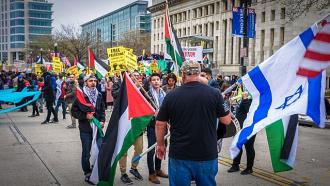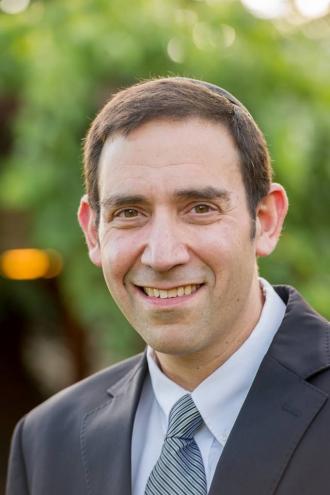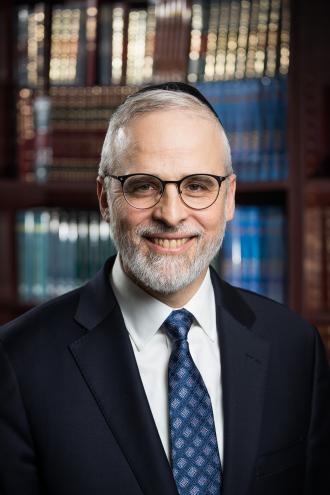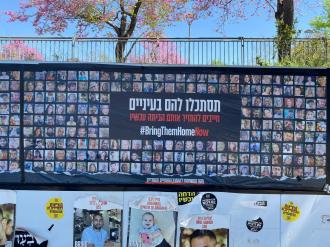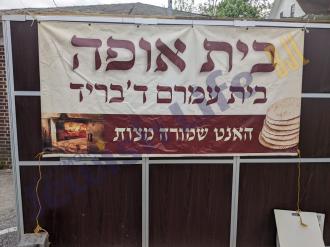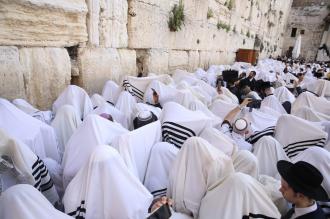Question #1: Davening in Public
“I am traveling, and the only place to daven is in a crowded terminal. Are there any special laws that I need to know?”
Question #2: Bowing or Genuflecting?
Have you ever genuflected?
Question #3: Bow and Arrow!
Does bowing have anything to do with bows and arrows?
Introduction:
Parshas Chayei Sarah mentions that Avraham bowed to the descendants of Cheis, when they agreed to give him a burial area for Sarah (Bereishis 23:7). The parsha also mentions that Eliezer bowed to Hashem to thank Him that his mission appeared to be achieving success. These provide a special opportunity to discuss some of the laws of bowing during the shemoneh esrei. As there is far more to this topic than can be covered in one article, we will, bli neder, have to return to the topic at some time in the future.
Thirteen components of tefillah
The Rambam rules that our daily mitzvah to daven includes thirteen factors, five of which are essential components of prayer that, if missing, require that davening be repeated. The headings of these five requirements are: Clean hands, proper covering of the body, cleanliness of the location, absence of physical bodily distractions, and proper focus (kavanah).
The other eight categories are important aspects for discharging the mitzvah, but someone who did not, or could not, observe them has still fulfilled the mitzvah. For example, there is a requirement to daven shemoneh esrei while standing and while facing the Beis Hamikdash. However, if someone could not, or did not, do either, he has fulfilled his mitzvah. Similarly, there is a requirement to bow at points during the shemoneh esrei, but someone who did not do so has fulfilled his mitzvah.
The Rambam (Hilchos Tefillah 5:10) explains that, for most people, davening requires that we bow five times in the course of the recital of the shemoneh esrei. I will explain shortly why I wrote “for most people.”
These five times are:
At the beginning and end of the first brocha of shemoneh esrei
At the beginning and end of the brocha of modim
At the very end of the shemoneh esrei
Most people?
Why did I say that the requirement to bow five times at every prayer is for “most people?”
This is because the Rambam (Hilchos Tefillah 5:10) alludes to the following passage of Talmud Yerushalmi (Brochos 1:5): “For the following brochos, one should bow: For the first brocha, both at the beginning and at the end, and for modim, both at the beginning and at the end. Someone who bows for every brocha should be taught not to do this. (See also Tosefta, Brochos 1:11 and Bavli, Brochos 34a.) Rabbi Yitzchak bar Nachman cited in the name of Rabbi Yehoshua ben Levi, ‘A kohein gadol bows at the end of every brocha; the king, at both the beginning and end of every brocha. Rabbi Simon quoted from Rabbi Yehoshua ben Levi, ‘The king – once he bows, he does not straighten up until he completes his entire prayer. What is my source? The verse that teaches, and it was when Shelomoh completed praying to Hashem this entire prayer and this entire supplication, that he then stood up from before the mizbei’ach of Hashem from bowing on his knees (Melachim I 8, 54).’”
We see that there is a dispute between Rabbi Yitzchak bar Nachman and Rabbi Simon (his name is not Shimon, but Simon, spelled with a samech, and he is an amora frequently quoted in the Yerushalmi) whether Shelomoh Hamelech teaches us that a king should always daven shemoneh esrei while kneeling, or whether this was a one-time practice, but not something that a king is always required to do.
Thus, those whom the Torah insists receive much honor must bow more frequently during their daily tefillah. The kohein gadol is required to bow in every brocha of shemoneh esrei, which is forbidden for everyone else, as we see in the above-referenced Tosefta. The Rambam rules according to Rabbi Simon, that the king, who receives much greater honor, is required to bow for his entire prayer.
Term limits?
This poses a question: The Tosefta rules that we should not bow in every brocha of shemoneh esrei; yet, we have now been taught that both the kohein gadol and the king should bow in each brocha of shemoneh esrei. How can it be that something is forbidden for everyone else and is required of the kohein gadol and the king?
The answer to this question seems to lie in the following explanation of Tosafos (Brochos 34a s.v. melamdin), who asks, “What is wrong with bowing extra times?” Tosafos provides two answers to the question (see also Tosafos Rabbeinu Yehudah and Bach, Orach Chayim 113):
1. If people develop the habit of bowing whenever they want to, it will cause Chazal’s takkanah (requiring that we bow at the beginning and end of only these two brochos) to become uprooted. Therefore, we insist that they not bow any extra times.
2. It is being ostentatious about his religious observance, a halachic concept called yohara.
The Tur (Orach Chayim 113) rules according to Tosafos. Based on Tosafos’s first answer, he concludes that it is permitted to bow in the middle of any brocha of shemoneh esrei, just not at the beginning or end.
We can also explain why Rabbi Yitzchak bar Nachman ruled that the kohein gadol and the king bowing in each brocha does not violate the ruling of the Tosefta. This was the takkanah – that a commoner bow only in two brochos, and the kohein gadol and king bow in each brocha.
When the bow breaks
As I mentioned above, the halacha is that bowing is not essential, which means that you fulfill the mitzvah to daven, even if you did not bow. There are extenuating circumstances in which you are not permitted to bow, but you are required to daven without bowing. The Shulchan Aruch (Orach Chayim 113:8) cites such a case -- someone who must daven in a public place, and a person opposite him is sporting a cross or other idolatrous image. The halacha is that you should daven but you should not bow, so that a bystander not think that you are bowing to the image.
Don’t bow to idols!
At this point, we can address our opening question: “I am traveling, and the only place to daven is in a crowded terminal. Are there any special laws that I need to know?”
The answer is that you should look around to see if any of your co-travelers are sporting crosses or other signs of idolatry, and, if they are, do not bow during your davening.
Take a bow
The Rambam mentioned that we are required to bow five times, including another time at the end of the shemoneh esrei, whose source is from a different passage of Gemara (Yoma 53b). “Rabbi Chiya, the son of Rav Huna, reported that he saw that Abayei and Rava would take three steps back while bowing.” This passage of Gemara is quoted not only by the Rambam, but also by the Rif and the Rosh (both at the end of the fifth chapter of Brochos, after they quote the other halachos about bowing during davening). Because of space considerations, we will have to leave the detailed discussion of the topic of bowing at the end of shemoneh esrei for a different time.
How can you bow?
We now have some background to understand the words of the Rambam and the other rishonim who rule that we are required to bow five times during the shemoneh esrei. However, we do not yet know what type of bowing is required. We do know from the verse in Melachim quoted above that when Shelomoh Hamelech bowed, he actually kneeled with both knees on the ground. We do not usually consider this to be a Jewish way of prayer, but associate it with other religions. What does the Torah teach about this?
In Tanach and Chazal we find at least five different levels of bowing, each with its own defining terms.
Hishtachavayah
Hishtachavayah is bowing in which a person is completely prostrate, with arms and legs stretched out completely flat on the ground (Megillah 22b; Shavuos 16b). The Gemara proves this from the rebuke that Yaakov gave to Yosef, after the latter told his father about his dream, havo navo ani ve’imcha ve’achecha lehishtachavos lecha artzah, “Will it happen that I, your mother and your brothers will bow (root: hishtachavayah) down to you to the ground?” Thus, we see that the word hishtachavayah refers to bowing all the way to the ground.
This type of bowing is mentioned several times in Tanach and the Gemara. Some people bow this way during the repetition of musaf on Yom Kippur when we “fall kor’im.”
Kidah
Kidah is kneeling and placing one’s face against the floor. On the basis of a posuk (Melachim I 1:31), the Gemara (Brochos 34b; Megillah 22b; Shavuos 16b) proves that this is the meaning of the word kidah. If you have ever seen how Moslems pray, this is what kidah is.
Korei’a al birkav
Korei’a al birkav is called, in English, kneeling. As I mentioned above, this is what the posuk describes Shelomoh Hamelech doing when he dedicated the Beis Hamikdash (Melachim I 8:54).
Shocheh
Shocheh is what in English is called bowing, which means lowering your head and upper part of your torso, but remain standing on your feet.
Kor’im
Kor’im or more accurately, keri’a (the root is spelled kof, reish, ayin, not to be confused with the word for reading, which is spelled kuf, reish, alef) is used at times to mean when you bow and also bend your knees as part of your bowing. In English, this is called genuflecting.
How do we bow?
The Gemara (Brochos 12a), cited by the Rambam (Hilchos Tefillah 5:10), rules: “Someone who is praying should bow at the word Boruch, and straighten himself to an upright position when he says the name of Hashem.” The Gemara continues: “Rav Sheishes, when he bowed, bowed down like a stick, when he straightened himself upright, he straightened himself like a snake.” Although there are other interpretations of this passage of Gemara, Rashi explains that Rav Sheishes bowed down in one motion, but when he straightened himself upright upon reciting the name of Hashem, he did so in two motions, his head first, and then the rest of his body, so that he should not give the impression that bowing was something that he did not want to do. The Rambam (Hilchos Tefillah 5:10) and the later authorities codify this as the proper method of bowing in shemoneh esrei. To quote the Rambam, “How should one bow? When he says Boruch, he should bend his knees; upon saying Attah, he should bow quickly; and upon saying Hashem’s name, he should slowly rise, his head first and then his body.” However, an older or ill person is not required to bow with his entire body, and it is sufficient if he simply bends his head. This last ruling is quoted in the Shulchan Aruch (Orach Chayim 113:5.)
Modim
In three of the places in the shemoneh esrei when we bow, we do so when saying the words Boruch Attah Hashem, and, according to the instructions that we have studied, we now know how to genuflect and bow when we say these prayers. However, the other two places, at the end of davening, and for modim, there is no “Boruch” in the tefillah when we bow. Therefore, at these places, common custom is to bow, but not genuflect (Mishnah Berurah).
Bow like a bow
This subtitle is not meant to be a corny pun, but an expression of the halacha. The Rambam (Hilchos Tefillah 5:12) rules: “All these bowings require that one bow until all the vertebrae in the spine protrude and (his back) is shaped like a bow.” In Hebrew, this is not a pun: the word for bow, keshes, and the word for bowing, korei’a, bear no similarity.
The source for the Rambam’s explanation is from the following passage of Gemara (Brochos 28b): Rav Tanchum quoted from Rabbi Yehoshua ben Levi, someone who is praying must bow until all the vertebrae in his spine protrude. Ulla said: Until a coin the size of an issar can be seen opposite his heart. Rav Chanina said, once he tilted his head, he is not required to do more. Rava explained Rav Chanina to mean that this is true when it is obvious that he is trying to bow more, but he is unable to do so, because of age or infirmity (see Tur and Shulchan Aruch, Orach Chayim 113).
The halachic authorities also rule that someone should not bow so low that his mouth is opposite his belt (Shulchan Aruch, Orach Chayim 113:5). This is because it looks like he is trying to show off (Mishnah Berurah).
Bowing or genuflecting?
At this point, let us refer to our second opening question: Have you ever genuflected?
Since we bend our knees when we say the word boruch, someone who davens three times a day and bows by bending his knees at the beginning and end of the first brocha and at the end of modim genuflects nine times a day. Thus, the surprising answer is that you probably genuflect many times a day, without knowing that you are doing so!
Genuflect, kneel, korei’a
There is a very interesting linguistic curiosity that I want to point out. The word genuflect comes from a contraction of two words, genu, related to knee, and flect, which means to bend. (Think of the English verbs deflect, flex.) Language experts explain that the origin of the word genu, which is Latin, and the words, knee and kneel, which are German, are of common origin, both coming from a common cognate ancestor that refers to the knee. This association is very surprising, because old German and pre-Latin languages, although both of Indo-European origin, have few common sources. When there are common roots in both, the origin of the word can invariably be traced to the time of the dor ha’pelagah, when the scattering of the nations occurred and the languages of mankind became divided. In these instances, the true root of the word is invariably Hebrew, notwithstanding that linguists categorize Hebrew as a Semitic language and not Indo-European. This rule bears true here again, once we realize that it is not unusual that a reish sound becomes a nun when changing languages, as in the example of Nevuchadnetzar, called Nevuchadretzar at times. Thus, since, according to Chazal (see Yoma 10a), German is the older of the two languages (German and Latin), clearly the original root was kof, reish, ayin, the shoresh of the word korei’a, which means to bow on one’s knee or knees, or to genuflect or kneel, with the reish becoming an “n” sound, first in German and then later in Latin. Thus, the English words knee and kneel and the Latin word genu all originate from the Hebrew word korei’a, or, more accurately, its root, kof, reish, ayin.
Conclusion
The power of tefillah is very great. Through tefillah one can save lives, bring people closer to Hashem, and overturn harsh decrees. We have to believe in this power. One should not think, “Who am I to daven to Hashem?” Rather, we must continually drive home the concept that Hashem wants our tefillos, and He listens to them! Man was created by Hashem as the only creation that has free choice. Therefore, our serving Hashem and our davening are unique in the entire spectrum of creation.
Understanding how much concern Chazal placed in the relatively minor aspects of davening should make us more aware of the fact that davening is our attempt at building a relationship with Hashem. As the Kuzari notes, every day should have three very high points -- the three times that we daven. Certainly, one should do whatever one can to make sure to pay attention to the meaning of the words of one's Tefillah. We should gain our strength and inspiration for the rest of the day from these three prayers. Let us hope that Hashem will accept our tefillos together with those of all Klal Yisrael!





